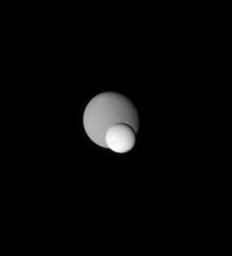
|
Enceladus and Dione
- Click the image above for a larger view
- Full-Res JPEG (346 x 382) (2.9 kB)
- Full-Res TIFF (346 x 382) (132.5 kB)
Caption:
Two icy moons meet on the sky in a "mutual event" recorded by the Cassini spacecraft.
The great brightness of Enceladus (505 kilometers, or 314 miles across) is rather obvious in comparison to Dione (1,126 kilometers, or 700 miles across) behind it. Enceladus is the most reflective object in the Solar System, and is nearly pure white. Dione, in comparison, reflects about 70 percent of the light falling upon it.
The image was taken in visible light with the Cassini spacecraft narrow-angle camera on July 24, 2007. The view was obtained at a distance of approximately 1.9 million kilometers (1.2 million miles) from Enceladus and 2.2 million kilometers (1.3 million miles) from Dione. Image scale is 11 kilometers (7 miles) per pixel on Enceladus and 13 kilometers (8 miles) per pixel on Dione.
Background Info:
The Cassini-Huygens mission is a cooperative project of NASA, the European Space Agency and the Italian Space Agency. The Jet Propulsion Laboratory, a division of the California Institute of Technology in Pasadena, manages the mission for NASA's Science Mission Directorate, Washington, D.C. The Cassini orbiter and its two onboard cameras were designed, developed and assembled at JPL. The imaging operations center is based at the Space Science Institute in Boulder, Colo.
For more information about the Cassini-Huygens mission visit http://saturn.jpl.nasa.gov/home/index.cfm . The Cassini imaging team homepage is at http://ciclops.org .
Cataloging Keywords:
| Name | Value | Additional Values |
|---|---|---|
| Target | Enceladus | Dione |
| System | Saturn | |
| Target Type | Satellite | |
| Mission | Cassini-Huygens | |
| Instrument Host | Cassini Orbiter | |
| Host Type | Orbiter | |
| Instrument | Imaging Science Subsystem (ISS) | |
| Detector | Narrow Angle Camera | |
| Extra Keywords | Grayscale, Visual | |
| Acquisition Date | ||
| Release Date | 2007-09-17 | |
| Date in Caption | 2007-07-24 | |
| Image Credit | NASA/JPL/Space Science Institute | |
| Source | photojournal.jpl.nasa.gov/catalog/PIA09729 | |
| Identifier | PIA09729 | |
